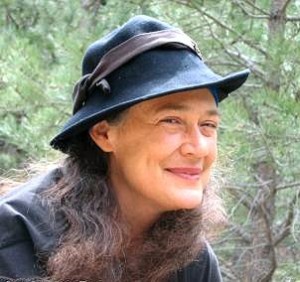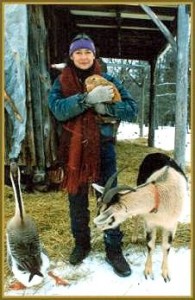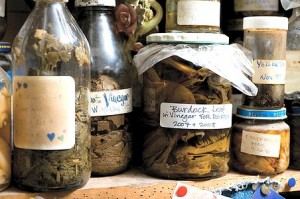Amazonian shamanism is, among other things, a form of herbal medicine. People who focus on the healing and transformative powers of ayahuasca may sometimes overlook the sheer size of the shamanic pharmacopoeia and the role that plant medicines play in healing. But to understand curanderismo in the Amazon, we have to understand these healing plants — their selection, preparation, indications, and application.
 |
| Susun Weed, herbalist |
My plant teacher doña María Tuesta Flores knew hundreds of plant medicines. The key to healing with plants, she told me, is not only to know which plant can heal which conditions, but also to understand the proper way to prepare the plants for use. “We have all these plants here,” she said, “cures for all sorts of diseases; now that you have learned about them, you must learn how to prepare them.” The practical use of the healing plants, she told me, I would learn in time from the plants themselves.
Before I began to study plant medicine in the Amazon, it was my great good fortune to have worked with several prominent herbalists in North America. The one who most influenced me — with her knowledge, wisdom, earthy humor, and audacious soul — was Susun Weed.
These two plant teachers, Susun Weed and María Tuesta, lived thousands of miles apart, and they never met. But they would have recognized each other instantly.
Weed is one of the best-known authorities on herbal medicine in North America. Although her focus has been on natural approaches to women’s health, her ideas on the nature of herbal medicine, the centrality of preventive care, the primary use of local and wild plants, and the way we must engage with the plant spirits — all of which she calls the Wise Woman Tradition — have universal application. What I learned from her was not only the uses of particular plants — dandelion and nettle and oatstraw — but also a way of thinking about plant healing, simultaneously practical and spiritual. “The Wise Woman Tradition,” she told an interviewer, “invites everyone to weave themselves into greater wholeness.”
 |
| Susun Weed with geese and goats |
Weed began studying herbal medicine in 1965, and she wrote her first book — Wise Woman Herbal for the Childbearing Year, now in its 29th printing — in 1985. Since then, she has written books on menopause and breast cancer, as well as Healing Wise, an introduction to her herbal philosophy and approach to the healing plants.
Weed travels throughout the world to speak at major conferences, medical schools, hospital wellness centers, breast cancer centers, midwifery schools, and shamanic training centers. She has frequently appeared on radio and television programs. Her contribution on herbal medicine appears in the Routledge International Encyclopedia of Women, and she writes a regular column in Sagewoman magazine. Her articles have appeared in Natural Health, Woman’s Day, and Herbs for Health.
“My goal,” she says, “is to change how we think about health and healing.” Herbal medicine is “simple, safe primary care… a gift of health from the green nations.” She continues: “My primary ally, my teacher in all things is Nature: the Earth and her many companions. I live with the plants, and the weather, and my goats.” Our relationship with the plants is a giveaway dance, she says. “You may lose your job and your health insurance, but the medicines of the earth will never abandon you. Green blessings are always waiting for us to recognize them and utilize them.”
Weed is thus an advocate of the common plants, especially those that grow locally and wild — what she calls kitchen remedies. “Knowing how wild plants affect health is part of knowing how to cook,” she said in a recent interview. “You don’t need a prescription to eat dinner.”
 |
| In Susun Weed’s kitchen |
Weed devotes much of her time to teaching. From March through November each year, she opens her home to students, apprentices, and visiting teachers. “Our workshops focus on the teachings of the Wise Woman Way, which nourishes wholeness through story, ceremony, and weeds.”
Her hands-on courses are the most popular — how to identify and pick the plants that grow on her property, how to use them when freshly picked, how to prepare tinctures, decoctions, teas, and vinegars from them. “I see how much confidence my students gain,” she says, “when we go out together to identify, pick, prepare and use the plants that grow around them.”
Some of her teaching methods are unorthodox. The students spend a good part of their time herding the goats, which requires them to be alone in nature for most of the day. “I do my best to create for the apprentices the same situations that allowed me to hear the plants speaking, that opened my heart to the ways of Nature… I want my students to learn as I learned, not what I learned. I want them to find their own way and to trust their own intuition.” Like doña María, she lets her students learn from the plants themselves.
In 2007, Weed was interviewed by herbalist John Gallagher. I have embedded the fifty-minute interview — split into five parts — in its entirety below. It is a wonderful way to get a sense of her warmth, humor, and spirit. She sets the tone right at the outset. “Herbal medicine,” she says, “is people’s medicine.”

- Previous Post: Amazonia Barbie
- Next Post: The Gift of Diabetes
- More Articles Related to: Plant Medicine, Sacred Plants



Thanks for posting. I love this woman. I was so stressed today, and just listening to her has relaxed me. Must get her book!
Thank you for the delightful blog post, honored to be here. Look for a link feature for your site in our next Herbal Ezine. Green Blessings, Susun Weed
I found you many years ago through your books and a dear friend when I was beginning my walk as a mom. You are one of the ones that showed me where to plant my feet and I have been walking with our Pacha Mama as a daughter ever since. Thank-you!
such a blessed confirmation that this is the next teacher i have asked to work with, thank you!
love the valerian story! sleepy bees :)))))